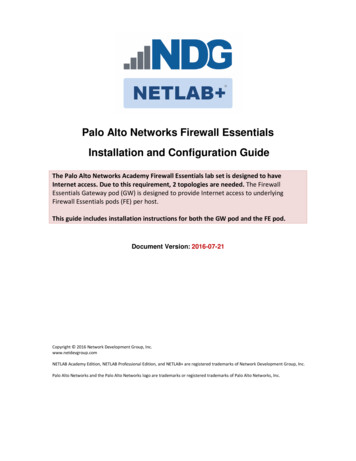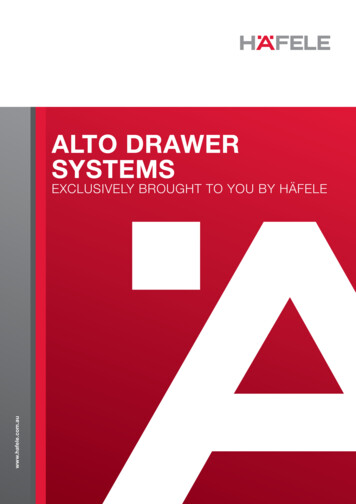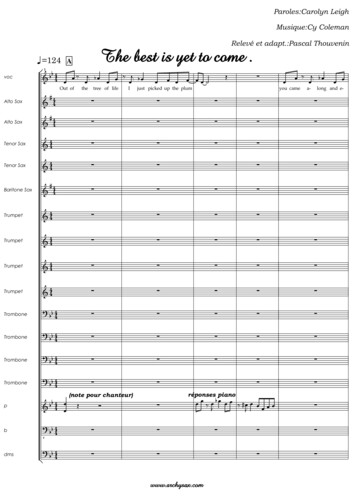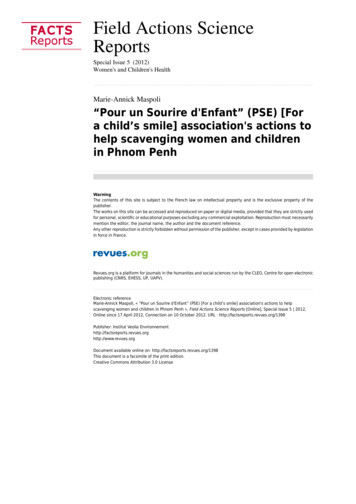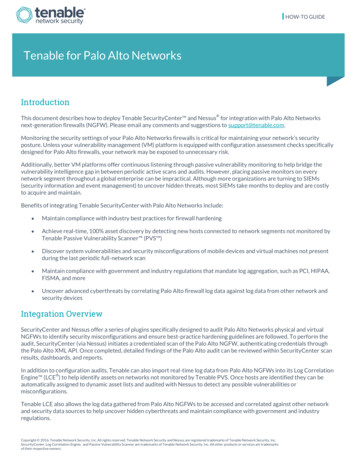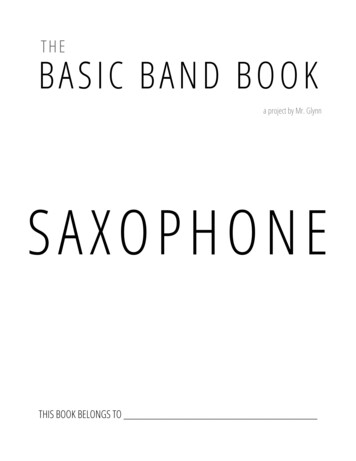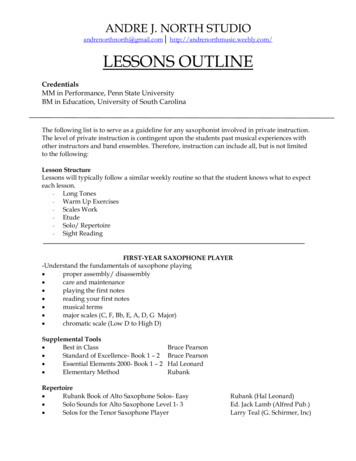
Transcription
AN ANNOTATED BIBLIOGRAPHY OF SELECTED REPERTOIRE FOR ALTOSAXOPHONE AND PIANO FOR DEVELOPING COLLEGE-LEVELALTO SAXOPHONISTS, WITH AN ANALYSIS OF YVON BOURREL’SSONATE POUR ALTO SAXOPHONE ET PIANOScott D. Kallestad, B.S., M.M.Dissertation Prepared for the Degree ofDOCTOR OF MUSICAL ARTSUNIVERSITY OF NORTH TEXASDecember 2005APPROVED:Eric M. Nestler, Major ProfessorEugene M. Corporon, Minor ProfessorDarhyl S. Ramsey, Committee MemberGraham H. Phipps, Director of GraduateStudies in the College of MusicJames C. Scott, Dean of the College of MusicSandra L. Terrell, Dean of the Robert B.Toulouse School of Graduate Studies
Kallestad, Scott D., An Annotated Bibliography of Selected Repertoire for AltoSaxophone and Piano for Developing College-Level Alto Saxophonists, with an Analysisof Yvon Bourrel’s Sonate Pour Alto Saxophone Et Piano. Doctor of Musical Arts(Performance), December 2005, 95 pp., 25 Figures, references, 82 titles.In this study the author addresses the problem of finding quality repertoire foryoung college-level saxophonists. By examining graded repertoire lists from a variety ofcollege and university saxophone instructors, the author has compiled a list of 180works for alto saxophone and piano. Twenty-four well-known works of a difficulty-levelappropriate for freshman and sophomore players are identified and annotated.Each annotation consists of bibliographical information, a biographical sketch ofthe composer, a difficulty rating of eight elements of performance, a discussion ofperformance considerations, and a bibliography of available recordings. The eightelements of performance included in the difficulty rating are: Meter, key signatures,tempo, note-values, rhythm, articulation, range, and dynamic levels. Each of thesefacets is graded using a six-point difficulty scale.The twenty-four selected works are:Sonate, Op. 115 - Jean AbsilSonata, No. 1 - Garland AndersonSerenade - Frank BencriscuttoSuite - Paul BonneauSonate, Op. 18 - Yvon BourrelAria - Eugène BozzaSonatina, Op. 36 - Lex van Delden
Sonate - Marc EychenneCinq Danses Exotiques - Jean FrançaixDiversion - Bernhard HeidenAria - Jacques IbertSonata - Wolfgang JacobiCantilène et Danse - Denis JolyMeditation - Walter KaufmannSicilienne - Pierre LantierBallade - Alfred ReedChanson et Passepied - Jeanine RueffParticles - Armand RussellSeven Epigrams - Randall SnyderRomance - William Grant StillSonatine Sportive - Alexandre TcherepninSarabande and Gigue - Fisher TullIntroduction and Samba - Maurice C. WhitneySonata - Alec WilderOne work from the select list, Yvon Bourrel’s Sonate Pour Saxophone Alto etPiano, has been analyzed in greater detail with regard to thematic material and keyareas to provide in-depth information that, hopefully, will help the student gain a deeperunderstanding of that work and as a result perform the piece with greater artistry.
Copyright 2005byScott D. Kallestadii
TABLE OF CONTENTSPageLIST OF FIGURES. vINTRODUCTION. 1Background and Significance . 1Purpose . 3Method . 4ANNOTATED BIBLIOGRAPHY . 12Sonate, Op. 115 - Jean Absil. 12Sonata, No. 1 - Garland Anderson . 13Serenade - Frank Bencriscutto . 15Suite - Paul Bonneau. 17Sonate, Op. 18 - Yvon Bourrel. 21Aria - Eugène Bozza. 23Sonatina, Op. 36 - Lex van Delden. 25Sonate - Marc Eychenne . 28Cinq Danses Exotiques - Jean Françaix. 31Diversion - Bernhard Heiden . 34Aria - Jacques Ibert . 37Sonata - Wolfgang Jacobi . 40Cantilène et Danse - Denis Joly . 43Meditation - Walter Kaufmann . 44Sicilienne - Pierre Lantier . 46Ballade - Alfred Reed . 48Chanson et Passepied - Jeanine Rueff . 50Particles - Armand Russell . 52Seven Epigrams - Randall Snyder. 54Romance - William Grant Still. 56Sonatine Sportive - Alexandre Tcherepnin . 59Sarabande and Gigue - Fisher Tull. 62Introduction and Samba - Maurice C. Whitney . 65iii
Sonata - Alec Wilder. 67YVON BOURREL’S SONATE POUR SAXOPHONE ALTO ET PIANO: A STUDY OFFORM, THEMATIC MATERIAL, AND KEY AREAS. 71First Movement – Modéré. 71Second Movement - Très Vif . 74Third Movement – “In Memoriam” . 76Fourth Movement- Animé . 77CONCLUSION . 79APPENDIX . 80Octave Designation Chart . 81Addresses of Publishers. 82Repertoire for Alto Saxophone and Piano Used in Selected Colleges andUniversities . 83BIBLIOGRAPHY . 90iv
LIST OF FIGURESPage1.Compositions selected for annotated bibliography . 52.Difficulty Level Chart. 93.Bonneau Suite, Mvt. 2, Measures 1-16 . 204.Bonneau Suite, Mvt. 3, Measures 30-32 . 215.Delden Sonatina, Mvt. 1, Measures 1-4 . 276.Delden Sonatina, Mvt. 3, Measures 11-13 . 287.Eychenne: Sonate, Mvt. 2, Measures 54-58. 308.Françaix: Cinq Danses Exotiques, Mvt. 4, Measures 1-2 . 339.Heiden Diversion tempos as recorded by Eugene Rousseau . 3610.Ibert Aria, Measure 23 . 3911.Ibert Aria, Measure 17 . 3912.Jacobi Sonata, Mvt. 2, Measures 6-7 . 4213.Jacobi Sonata, Mvt. 2, Measures 47-49 . 4214.Tcherepnin Sonatine Sportive, Mvt. 3, Measures 1-5. 6115.Tull Sarabande and Gigue, Mvt. 2, Measures 54-60 . 6416.Wilder Sonata, Mvt. 1, Measures 51-53 . 6917.Bourrel Sonate, Movement 1, Form. 7218.Bourrel Sonate, Mvt. 1, Measures 1-4, First Theme . 7219.Bourrel Sonate, Mvt. 1, Measures 21-24, Second Theme. 7320.Bourrel Sonate, Mvt. 1, Form, Themes, and Key Areas . 7421.Bourrel Sonate, Mvt. 2, Form, Themes, and Key Areas . 7522.Bourrel Sonate, Mvt. 2, Measures 1-11: Theme “a” in Canon . 7623.Bourrel Sonate, Mvt. 3, Form, Themes, and Key Areas . 77v
24.Bourrel Sonate, Mvt. 4, Form, Themes and Key Areas . 7725.Bourrel Sonate, Mvt. 4, Measures 31-34 . 78vi
INTRODUCTIONBackground and SignificanceA great wealth of repertoire for the saxophone has been composed in the lastcentury and a half. A recent publication by Jean-Marie Londeix “documents over 18,000published and available works for saxophone.”1 Approximately 1,900 of these works arecomposed for alto saxophone and piano, presenting an overwhelming repertoire fromwhich to choose.There have been many repertoire lists, annotated bibliographies, and analyticalstudies written during the past 35 years that pertain to repertoire for the saxophone.These lists have taken many forms ranging from simple databases of composers andtitles, to more extensive bibliographies that include names and dates of composers,titles, year of publication, publisher, difficulty level, composer biographies, andsometimes brief descriptions of the works. Several annotated bibliographies have beenwritten that discuss the saxophone repertoire of specific composers such as WarrenBenson,2 Paul Bonneau,3 Paul Creston,4 Pierre-Max Dubois,5 Jindřich Feld,6 Charles1Jean-Marie Londeix. A Comprehensive Guide to the Saxophone Repertoire: 1844-2003. CherryHill, NJ: Roncorp, 2003, p. vi.2Alan Dale Wagner. “The Life and Works for Warren Benson: A Descriptive Catalog.” (Ph.D.diss., The Florida State University, 2000).3Keith Terry Johnson. “A Theoretical Analysis of Selected Solo Repertoire for Saxophone by PaulBonneau.” (DMA diss., University of North Texas, 2002).4Willie Lee Morris, III. “The Development of the Saxophone Compositions of Paul Creston.” (DMAdiss., University of Missouri – Kansas City, 1996).5William Edwin Bingham. “Pierre-Max Dubois: A Performance Guide to Selected Works for theSaxophone.” (DMA diss., University of Kentucky, 1988).1
789Koechlin, Lucie Robert, Heitor Villa-Lobos, and more. Dissertations have beenwritten that discuss concerti for soprano saxophone and orchestra,works for alto saxophone,1980s,1211141713compositions forrepertoire commissioned by Elise Boyer Hall,pedagogical contributions of Larry Teal,Sax,unaccompaniedsonatas for alto saxophone and piano composed during thetenor saxophone repertoire for college-level players,saxophone and percussion,101615thesaxophone music published by Adolpheand more. In addition, many great works for saxophone have been treated todetailed analytical or comparative study, including works by Leslie Bassett,18ClaudeDebussy,19 Bernhard Heiden,20 and Jacques Ibert21 just to mention a few.6Jennifer Lynn Filer Turpen. “A Descriptive Catalog of the Solo and Chamber Works for theSaxophone by Jindřich Feld.” (DMA diss., University of Georgia, 2000).7Keith Ray Young. “The Solo and Chamber Saxophone Music of Charles Koechlin (1867-1950).”(DMA diss., University of Maryland College Park, 1991).8John Stephen Bleuel. “ A Descriptive Catalog of the Solo and Chamber Saxophone Music ofLucie Robert.” (DMA diss., University of Georgia, 1998).9James Dale Butler. “Heitor Villa-Lobos: The Compositional Use of the Saxophone in Orchestral,Chamber and Solo Repertoire.” (DMA diss., The University of Texas at Austin, 1995).10Robert L. Foster. “Concerto for Soprano Saxophone and Orchestra: a Composition WithAnalysis, and a Survey of Existing Literature.” (DA diss., University of Northern Colorado, 1999).11Brian Lynn Trittin. “Annotated Bibliography of Selected Unaccompanied Alto SaxophoneLiterature.” (A.Mus.D. diss., The University of Arizona, 1993).12Gregory Kim Gast. “Annotated Bibliography of Alto Saxophone Sonatas Published From 19801990.” (DA diss., University of Northern Colorado, 1994).13Samuel Wilson Fagaly. “A Pedagogical, Descriptive Catalog of Recommended Literature at theCollege Level for the Tenor Saxophone.” (DA diss., University of Northern Colorado, 1998).14Barry Eugene McGinnis. “An Annotated Bibliography of Selected Published Works forSaxophone and Percussion by North American Composers.” (DMA diss., University of Georgia, 2002).15William Henry S
Benson,2 Paul Bonneau,3 Paul Creston,4 Pierre-Max Dubois,5 Jindřich Feld,6 Charles 1 Jean-Marie Londeix. A Comprehensive Guide to the Saxophone Repertoire: 1844-2003. Cherry Hill, NJ: Roncorp, 2003, p. vi. 2 Alan Dale Wagner. “The Life and Works for Warren Benson: A Descriptive Catalog.” (Ph.D. diss., The Florida State University, 2000). 3 Keith Terry Johnson. “A Theoretical Analysis of .

